Climatic Changes and Vegetation Responses During Holocene Characteristic Period in the Northeastern Qinghai–Tibet Plateau
Abstract
1. Introduction
2. Materials and Methods
2.1. Data Collection and Processing
2.2. Paleoclimate Reconstruction Methods
2.3. Calculation of Vegetation Response
3. Results
3.1. Holocene Characteristic Period and Climate Change
3.2. Vegetation Response
4. Discussion
5. Conclusions
Author Contributions
Funding
Institutional Review Board Statement
Informed Consent Statement
Data Availability Statement
Acknowledgments
Conflicts of Interest
Appendix A
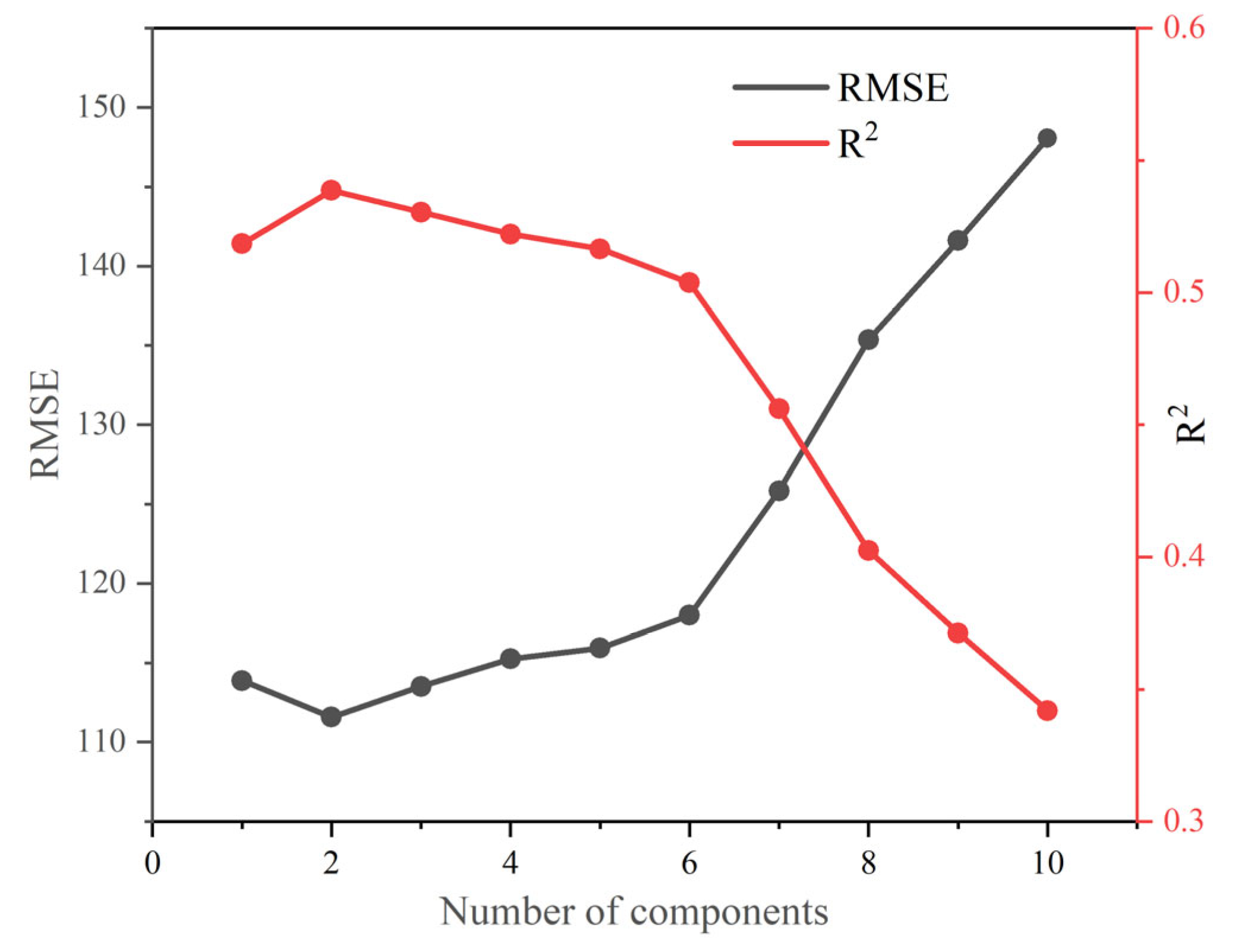
Appendix B
| Pollen | Tmax | Tmin | Avg | Prcp |
|---|---|---|---|---|
| Abies | r = 0.657 | - | r = 0.412 | r = 0.456 |
| p < 0.0001 | - | p < 0.0001 | p < 0.0001 | |
| Betula | - | r = −0.190 | - | - |
| - | p = 0.042 | - | - | |
| Picea | - | r = −0.444 | - | r = 0.609 |
| - | p < 0.0001 | - | p < 0.0001 | |
| Pinus | r = 0.764 | r = 0.448 | r = 0.665 | r = 0.722 |
| p < 0.0001 | p < 0.0001 | p < 0.0001 | p < 0.0001 | |
| Artemisia | r = −0.183 | - | - | r = −0.460 |
| p = 0.0497 | - | - | p < 0.0001 | |
| Asteraceae | - | r = −0.438 | r = −0.341 | - |
| - | p < 0.0001 | p = 0.000191 | - | |
| Chenopodiaceae | - | r = 0.447 | - | r = −0.415 |
| - | p < 0.0001 | - | p < 0.0001 | |
| Cyperaceae | r = −0.237 | - | r = −0.188 | - |
| p = 0.0108 | - | p = 0.0447 | - | |
| Ephedra | r = 0.263 | - | - | - |
| p = 0.00445 | - | - | - | |
| Poaceae | r = −0.207 | - | - | - |
| p = 0.0265 | - | - | - |
References
- Lee, H.; Calvin, K.; Dasgupta, D.; Krinner, G.; Mukherji, A.; Thorne, P.; Trisos, C.; Romero, J.; Aldunce, P.; Aldunce, P.; et al. Climate Change 2023: Synthesis Report. Contribution of Working Groups, and to the Sixth Assessment Report of the Intergovernmental Panel on Climate Change; IPCC: Geneva, Switzerland, 2023; pp. 1–34. [Google Scholar]
- Kotz, M.; Levermann, A.; Wenz, L. The Economic Commitment to Climate Change. Nature 2024, 628, 551–557. [Google Scholar] [CrossRef] [PubMed]
- Pereira, H.M.; Martins, I.S.; Rosa, I.M.; Kim, H.; Leadley, P.; Popp, A.; van Vuuren, D.P.; Hurtt, G.; Quoss, L.; Arneth, A.; et al. Global Trends and Scenarios for Terrestrial Biodiversity and Ecosystem Services from 1900 to 2050. Science 2024, 384, 458–465. [Google Scholar] [CrossRef] [PubMed]
- Sun, X.; Du, N.; Weng, C.; Lin, R.; Wei, K. Paleovegetation and Paleoenvironment of Manasi Lake, Xinjiang, N.W. China during the Last 14000 Years. Quat. Sci. 1994, 3, 239–248. [Google Scholar]
- Xu, Q.; Chen, F.; Zhang, S.; Cao, X.; Li, J.; Li, Y.; Li, M.; Chen, J.; Liu, J.; Wang, Z. Vegetation Succession and East Asian Summer Monsoon Changes since the Last Deglaciation Inferred from High-Resolution Pollen Record in Gonghai Lake, Shanxi Province, China. Holocene 2017, 27, 835–846. [Google Scholar] [CrossRef]
- Chen, F.; Xu, Q.; Chen, J.; Birks, H.J.; Liu, J.; Zhang, S.; Jin, L.; An, C.; Telford, R.J.; Cao, X.; et al. East Asian Summer Monsoon Precipitation Variability since the Last Deglaciation. Sci. Rep. 2015, 5, 11186. [Google Scholar] [CrossRef]
- Herzschuh, U.; Cao, X.; Laepple, T.; Dallmeyer, A.; Telford, R.J.; Ni, J.; Chen, F.; Kong, Z.; Liu, G.; Liu, K.B.; et al. Position and Orientation of the Westerly Jet Determined Holocene Rainfall Patterns in China. Nat. Commun. 2019, 10, 2376. [Google Scholar] [CrossRef]
- Yu, Y.; Wu, H.; Li, Q.; Sun, A.; Luo, Y. Changes of Terrestrial Carbon Storage Induced by Natural Vegetation Evolution in the Wei River Valley of Northern China during the Holocene. Quat. Sci. 2023, 43, 345–355. [Google Scholar]
- Zhao, Y.; Tzedakis, P.C.; Li, Q.; Qin, F.; Cui, Q.; Liang, C.; Birks, H.J.; Liu, Y.; Zhang, Z.; Ge, J.; et al. Evolution of Vegetation and Climate Variability on the Tibetan Plateau over the Past 1.74 Million Years. Sci. Adv. 2020, 6, eaay6193. [Google Scholar] [CrossRef]
- Chen, H.; Hou, G.; Wende, Z.; Qiao, H.; Gao, J.; Jin, S. Distribution and Evolution of Pinus spp. Vegetation in the Tibetan Plateau during the Last Glacial Maximum and Holocene. Quat. Sci. 2023, 43, 1211–1224. [Google Scholar]
- Wan, Z.; Zhang, H.; Nie, J.; Zhao, Y.; Miao, Y.; Zhang, X.; Zhao, X.; Wang, Z. Pollen Assemblages and Paleoclimate Changes from 30 ka B.P. to 5 ka B.P. in Zambezi River Basin, Southern Africa. Quat. Sci. 2023, 43, 899–910. [Google Scholar]
- Laborda-López, C.; Martín-Perea, D.M.; Del Castillo, E.; Linares, M.A.; Iannicelli, C.; Pal, S.; Arroyo, X.; Agustí, J.; Piñero, P. Sedimentological Evolution of the Quibas Site: High-Resolution Glacial/Interglacial Dynamics in a Terrestrial Pre-Jaramillo to Post-Jaramillo Sequence from Southern Iberian Peninsula. Quat. Int. 2024, 692, 28–44. [Google Scholar] [CrossRef]
- Wang, H.; Kang, C.; Tian, Z.; Zhang, A.; Cao, Y. Vegetation Periodic Changes and Relationships with Climate in Inner Mongolia Based on the VMD Method. Ecol. Indic. 2023, 146, 109764. [Google Scholar] [CrossRef]
- Shinker, J.J.; Mock, C.J. Modern Synoptic and Late Quaternary Climate Analog Approaches in Paleoclimatology. In Reference Module in Earth Systems and Environmental Sciences; Elsevier: Amsterdam, The Netherlands, 2023; ISBN 9780124095489. [Google Scholar]
- Wang, L.; Jian, X.; Fu, H.; Zhang, W.; Shang, F.; Fu, L. Decoupled Local Climate and Chemical Weathering Intensity of Fine-Grained Siliciclastic Sediments from a Paleo-Megalake: An Example from the Qaidam Basin, Northern Tibetan Plateau. Sediment. Geol. 2023, 454, 106462. [Google Scholar] [CrossRef]
- Hu, H.; Passey, B.H.; Lehmann, S.B.; Levin, N.E.; Johnson, B.J. Modeling and Interpreting Triple Oxygen Isotope Variations in Vertebrates, with Implications for Paleoclimate and Paleoecology. Chem. Geol. 2023, 642, 121812. [Google Scholar] [CrossRef]
- Bell, A.R.; Osgood, D.E.; Cook, B.I.; Anchukaitis, K.J.; McCarney, G.R.; Greene, A.M.; Buckley, B.M.; Cook, E.R. Paleoclimate Histories Improve Access and Sustainability in Index Insurance Programs. Glob. Environ. Change 2013, 23, 774–781. [Google Scholar] [CrossRef]
- Zimmerman, S.R.H.; Wahl, D.B. Holocene Paleoclimate Change in the Western US: The Importance of Chronology in Discerning Patterns and Drivers. Quat. Sci. Rev. 2020, 246, 106487. [Google Scholar] [CrossRef]
- Kröpelin, S.T.; Verschuren, D.; Lézine, A.M.; Eggermont, H.; Cocquyt, C.; Francus, P.; Cazet, J.P.; Fagot, M.; Rumes, B.; Russell, J.M.; et al. Climate-Driven Ecosystem Succession in the Sahara: The Past 6000 Years. Science 2008, 320, 765–768. [Google Scholar]
- Xu, D.; Lu, H.; Chu, G.; Wu, N.; Shen, C.; Wang, C.; Mao, L. 500-Year Climate Cycles Stacking of Recent Centennial Warming Documented in an East Asian Pollen Record. Sci. Rep. 2014, 4, 3611. [Google Scholar] [CrossRef]
- Miao, Y.; Lei, Y.; Zhao, Y.; Lan, X. Current Research and Prospect of Airborne Sporopollen in the Inland Arid Areas of Asia. Quat. Sci. 2024, 44, 688–703. [Google Scholar]
- Qin, F.; Zhao, Y. Pollen-Based Climate Reconstruction Using Machine Learning on the Qinghai-Tibetan Plateau. Quat. Sci. 2024, 44, 704–714. [Google Scholar]
- Hou, J.; Wang, M.; Ma, C.; Yuan, C.; Wang, X.; Chen, S.; Xiao, X.; Zheng, Z.; Zhao, Y. Study on the Relationship of Surface Pollen, Vegetation, and Climate along a Precipitation Gradient in China. Quat. Sci. 2024, 44, 623–637. [Google Scholar]
- Liu, X.; Shen, J.; Wang, S.; Yang, X.; Tong, G.; Zhang, E. A 16000-Year Pollen Record of Qinghai Lake and Its Paleoclimate and Paleoenvironment. Chin. Sci. Bull. 2002, 47, 1931–1936. [Google Scholar]
- Cheng, B.; Chen, F.H.; Zhang, J.W. Palaeovegetational and Palaeoenvironmental Changes since the Last Deglacial in Gonghe Basin, Northeast Tibetan Plateau. J. Geogr. Sci. 2013, 23, 136–146. [Google Scholar]
- Zhao, Y.; Liu, H.; Li, F.; Huang, X.; Sun, J.; Zhao, W.; Herzschuh, U.; Tang, Y. Application and Limitations of the Artemisia/Chenopodiaceae Pollen Ratio in Arid and Semi-Arid China. Holocene 2012, 22, 1385–1392. [Google Scholar] [CrossRef]
- Ma, Q.; Zhu, L.; Wang, J.; Ju, J.; Lü, X.; Wang, Y.; Guo, Y.; Yang, R.; Kasper, T.; Haberzettl, T.; et al. Artemisia/Chenopodiaceae Ratio from Surface Lake Sediments on the Central and Western Tibetan Plateau and Its Application. Palaeogeogr. Palaeoclimatol. Palaeoecol. 2017, 479, 138–145. [Google Scholar]
- Chevalier, M.; Davis, B.A.; Heiri, O.; Seppä, H.; Chase, B.M.; Gajewski, K.; Lacourse, T.; Telford, R.J.; Finsinger, W.; Guiot, J.; et al. Pollen-Based Climate Reconstruction Techniques for Late Quaternary Studies. Earth-Sci. Rev. 2020, 210, 103384. [Google Scholar]
- Wang, Z.; Fan, H.; Wang, D.; Xing, T.; Wang, D.; Guo, Q.; Xiu, L. Spatial Pattern of Highway Transport Dominance in Qinghai–Tibet Plateau at the County Scale. ISPRS Int. J. Geo-Inf. 2021, 10, 304. [Google Scholar] [CrossRef]
- Jin, S.; Wang, Y.; Hou, G.; Li, S. Quantitative Reconstruction of Precipitation on Qinghai-Tibet Plateau from Holocene Pollen Records. Bull. Soil Water Conserv. 2018, 38, 169–176. [Google Scholar]
- Zhang, S.; E, C.; Ji, X.; Li, P.; Peng, Q.; Zhang, Z.; Zhang, Q. Soil Genesis of Alluvial Parent Material in the Qinghai Lake Basin (NE Qinghai–Tibet Plateau) Revealed Using Optically Stimulated Luminescence Dating. Atmosphere 2024, 15, 1066. [Google Scholar] [CrossRef]
- Ren, W.; Liu, Z.; Li, Q.; Yi, G.; Qin, F. Extreme Hydroclimatic Events and Response of Vegetation in the Eastern QTP since 10 ka. Open Geosci. 2024, 16, 20220717. [Google Scholar] [CrossRef]
- Liu, H.; Yin, Y.; Hao, Q.; Liu, G. Sensitivity of Temperate Vegetation to Holocene Development of East Asian Monsoon. Quat. Sci. Rev. 2014, 98, 126–134. [Google Scholar] [CrossRef]
- Cao, X.; Tian, F.; Herzschuh, U.; Ni, J.; Xu, Q.; Li, W.; Zhang, Y.; Luo, M.; Chen, F. Human activities have reduced plant diversity in eastern China over the last two millennia. Glob. Change Biol. 2022, 28, 4962–4976. [Google Scholar] [CrossRef] [PubMed]
- Wang, Q.; Hamilton, P.B.; Xu, M.; Kattel, G. Comparison of Boosted Regression Trees vs WA-PLS Regression on Diatom-Inferred Glacial-Interglacial Climate Reconstruction in Lake Tiancai (Southwest China). Quat. Int. 2021, 580, 53–66. [Google Scholar] [CrossRef]
- Silalahi, D.D.; Midi, H.; Arasan, J.; Mustafa, M.S.; Caliman, J.-P. Automated Fitting Process Using Robust Reliable Weighted Average on Near Infrared Spectral Data Analysis. Symmetry 2020, 12, 2099. [Google Scholar] [CrossRef]
- Liu, J.; Zhang, Y. An Attribute Weighted Bayesian Classifier Based on Asymmetric Correlation Coefficient. Int. J. Pattern Recognit. Artif. Intell. 2020, 34, 2050025. [Google Scholar] [CrossRef]
- Zhu, K. A Preliminary Study on the Climatic Fluctuation during the Last 5000 Years in China. Meteorol. Sci. Technol. 1973, S1, 2–23. [Google Scholar] [CrossRef]
- Shi, Y.F. Climates and Environments of the Holocene Megathermal Maximum in China. Sci. China-Chem. 1994, 37, 481. [Google Scholar]
- Anwar, T.; Kravchinsky, V.A.; Zhang, R.; Koukhar, L.P.; Yang, L.; Yue, L. Holocene Climatic Evolution at the Chinese Loess Plateau: Testing Sensitivity to the Global Warming-Cooling Events. J. Asian Earth Sci. 2018, 166, 223–232. [Google Scholar] [CrossRef]
- Cai, D.; You, Q.; Fraedrich, K.; Guan, Y. Spatiotemporal Temperature Variability over the Tibetan Plateau: Altitudinal Dependence Associated with the Global Warming Hiatus. J. Clim. 2017, 30, 969–984. [Google Scholar] [CrossRef]
- Brown, K.J.; Seppä, H.; Schoups, G.; Fausto, R.S.; Rasmussen, P.; Birks, H.J. A Spatio-Temporal Reconstruction of Holocene Temperature Change in Southern Scandinavia. Holocene 2011, 22, 165–177. [Google Scholar] [CrossRef]
- Mischke, S.; Zhang, C. Holocene Cold Events on the Tibetan Plateau. Glob. Planet. Chang. 2010, 72, 155–163. [Google Scholar] [CrossRef]
- Triantaphyllou, M.V.; Gogou, A.; Bouloubassi, I.; Dimiza, M.; Kouli, K.; Rousakis, G.; Kotthoff, U.; Emeis, K.C.; Papanikolaou, M.; Athanasiou, M.; et al. Evidence for a Warm and Humid Mid-Holocene Episode in the Aegean and Northern Levantine Seas (Greece, NE Mediterranean). Reg. Environ. Change 2013, 14, 1697–1712. [Google Scholar] [CrossRef]
- Li, X.; Zhao, C.; Zhou, X. Vegetation Pattern of Northeast China during the Special Periods since the Last Glacial Maximum. Sci. China Earth Sci. 2019, 62, 1224–1240. [Google Scholar] [CrossRef]
- Jensen, K. Some West Baltic Pollen Diagrams. Quaternary 1938, 1, 124–139. [Google Scholar]
- Yan, D.; Wünnemann, B.; Zhang, Y.; Andersen, N. Holocene Climatic and Tectonic Forcing of Decadal Hydroclimate Variation on the North-Eastern Tibetan Plateau. Quat. Sci. Rev. 2024, 326, 108514. [Google Scholar] [CrossRef]
- Wang, S. 8.2 ka BP Cold Event. Adv. Clim. Chang. Res. 2008, 3, 193–194. [Google Scholar]
- Heinrich, H. Origin and Consequences of Cyclic Ice Rafting in the Northeast Atlantic Ocean during the Past 130000 Years. Quat. Res. 1988, 29, 142–152. [Google Scholar] [CrossRef]
- Chen, H.; Zhu, L.; Hou, J.; Steinman, B.A.; He, Y.; Brown, E.T. Westerlies Effect in Holocene Paleoclimate Records from the Central Qinghai-Tibet Plateau. Palaeogeogr. Palaeoclimatol. Palaeoecol. 2022, 598, 111036. [Google Scholar] [CrossRef]
- Lv, F.; Chen, J.; Zhou, A.; Cao, X.; Zhang, X.; Wang, Z.; Wu, D.; Chen, X.; Yan, J.; Wang, H.; et al. Vegetation History and Precipitation Changes in the NE Qinghai-Tibet Plateau: A 7900-Year Pollen Record from Caodalian Lake. Paleoceanogr. Paleoclimatol. 2021, 36, e2020PA004126. [Google Scholar] [CrossRef]
- Wende, Z.; Hou, G.; Chen, H.; Jin, S.; Zhuoma, L. Dynamic Changes in Forest Cover and Human Activities during the Holocene on the Northeast Tibetan Plateau. Front. Earth Sci. 2023, 11, 1128824. [Google Scholar] [CrossRef]
- Herzschuh, U.; Birks, H.J.; Ni, J.; Zhao, Y.; Liu, H.; Liu, X.; Grosse, G. Holocene Land-Cover Changes on the Tibetan Plateau. Holocene 2009, 20, 91–104. [Google Scholar] [CrossRef]
- Sun, X.; Zhao, Y.; Li, Q. Holocene Peatland Development and Vegetation Changes in the Zoige Basin, Eastern Tibetan Plateau. Sci. China Earth Sci. 2017, 60, 1826–1837. [Google Scholar] [CrossRef]
- Wang, T.; Huang, X.; Zhang, J.; Luo, D.; Zheng, M.; Xiang, L.; Sun, M.; Ren, X.; Sun, Y.; Zhang, S. Vegetation Cover Dynamics on the Northeastern Qinghai-Tibet Plateau since Late Marine Isotope Stage 3. Quat. Sci. Rev. 2023, 318, 108292. [Google Scholar] [CrossRef]
- Hou, G.; Yang, P.; Cao, G.; Chongyi, E.; Wang, Q. Vegetation Evolution and Human Expansion on the Qinghai–Tibet Plateau since the Last Deglaciation. Quat. Int. 2017, 430 Pt B, 82–93. [Google Scholar] [CrossRef]
- Lv, F.; Wang, X.; Liu, F.; Wan, D.; Zhou, K.; Zhang, P.; Peng, Y.; Zhang, S. Vegetation, Temperature, and Indian Summer Monsoon Evolution over the Past 4400 Years Revealed by a Pollen Record from Drigo Co on the Southern Qinghai-Tibet Plateau. Palaeogeogr. Palaeoclimatol. Palaeoecol. 2024, 655, 112556. [Google Scholar] [CrossRef]
- Huang, X.Z.; Liu, S.S.; Dong, G.H.; Qiang, M.R.; Bai, Z.J.; Zhao, Y.; Chen, F.H. Early Human Impacts on Vegetation on the Northeastern Qinghai-Tibetan Plateau during the Middle to Late Holocene. Prog. Phys. Geogr. 2017, 41, 286–301. [Google Scholar]
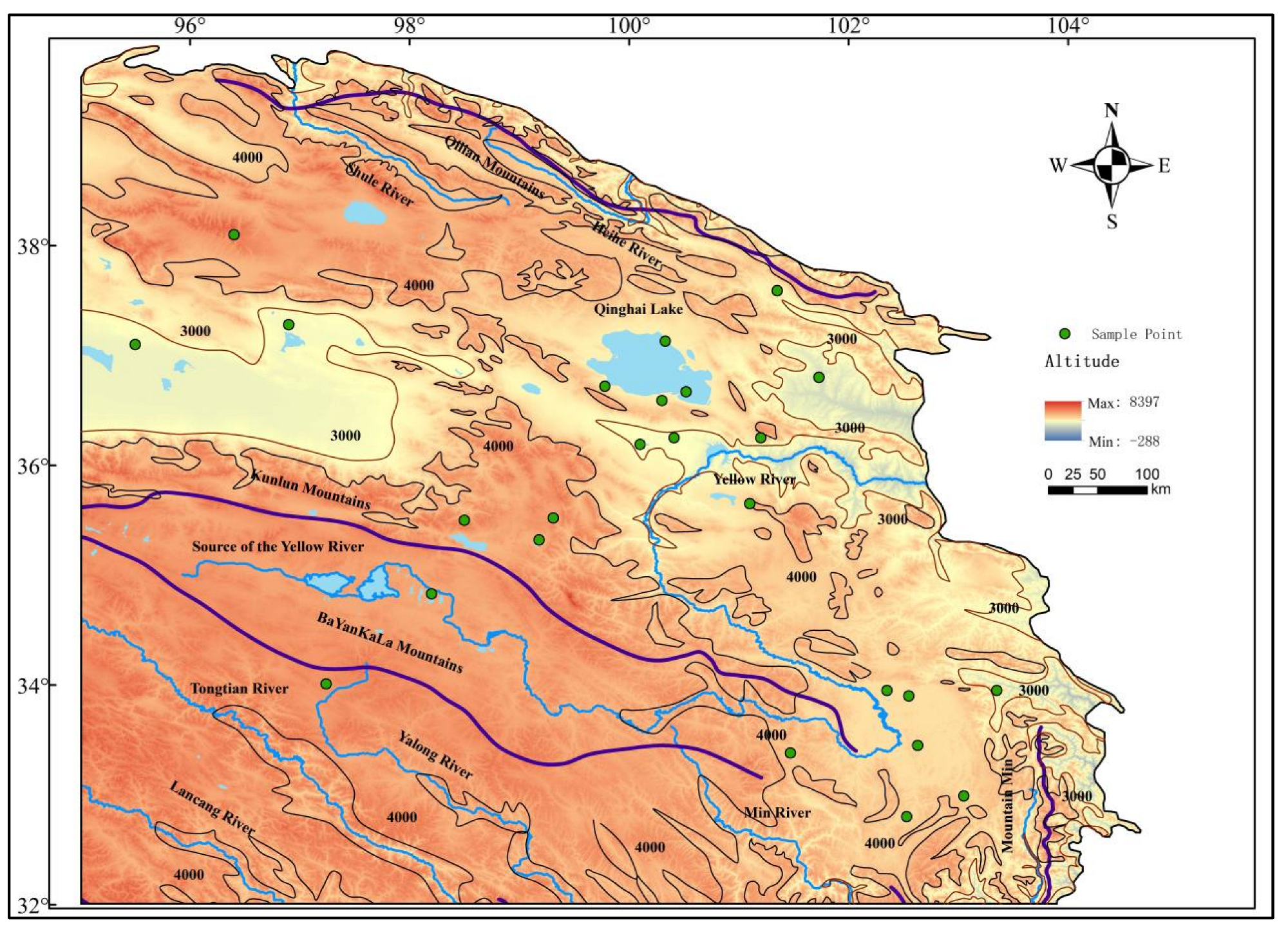

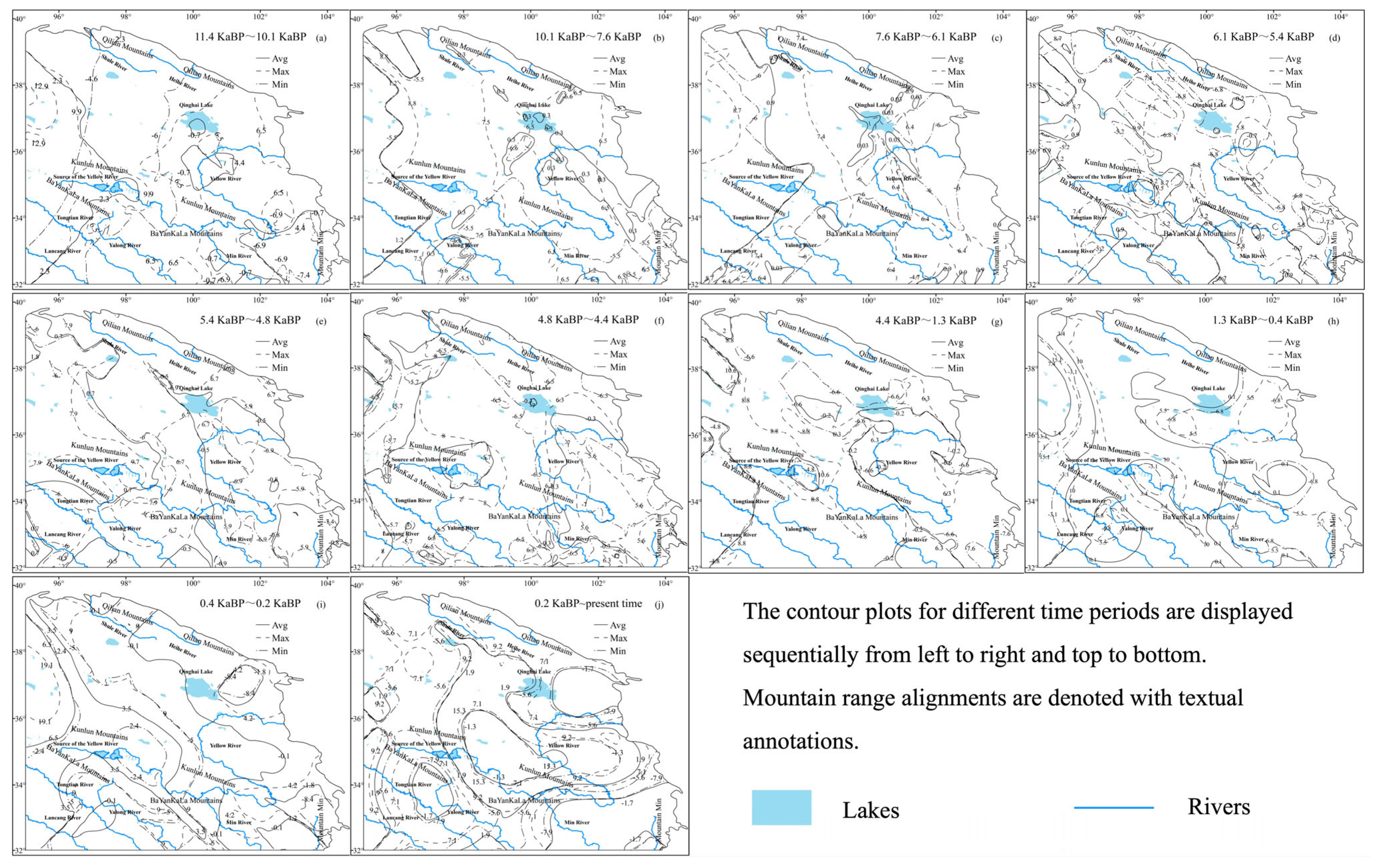
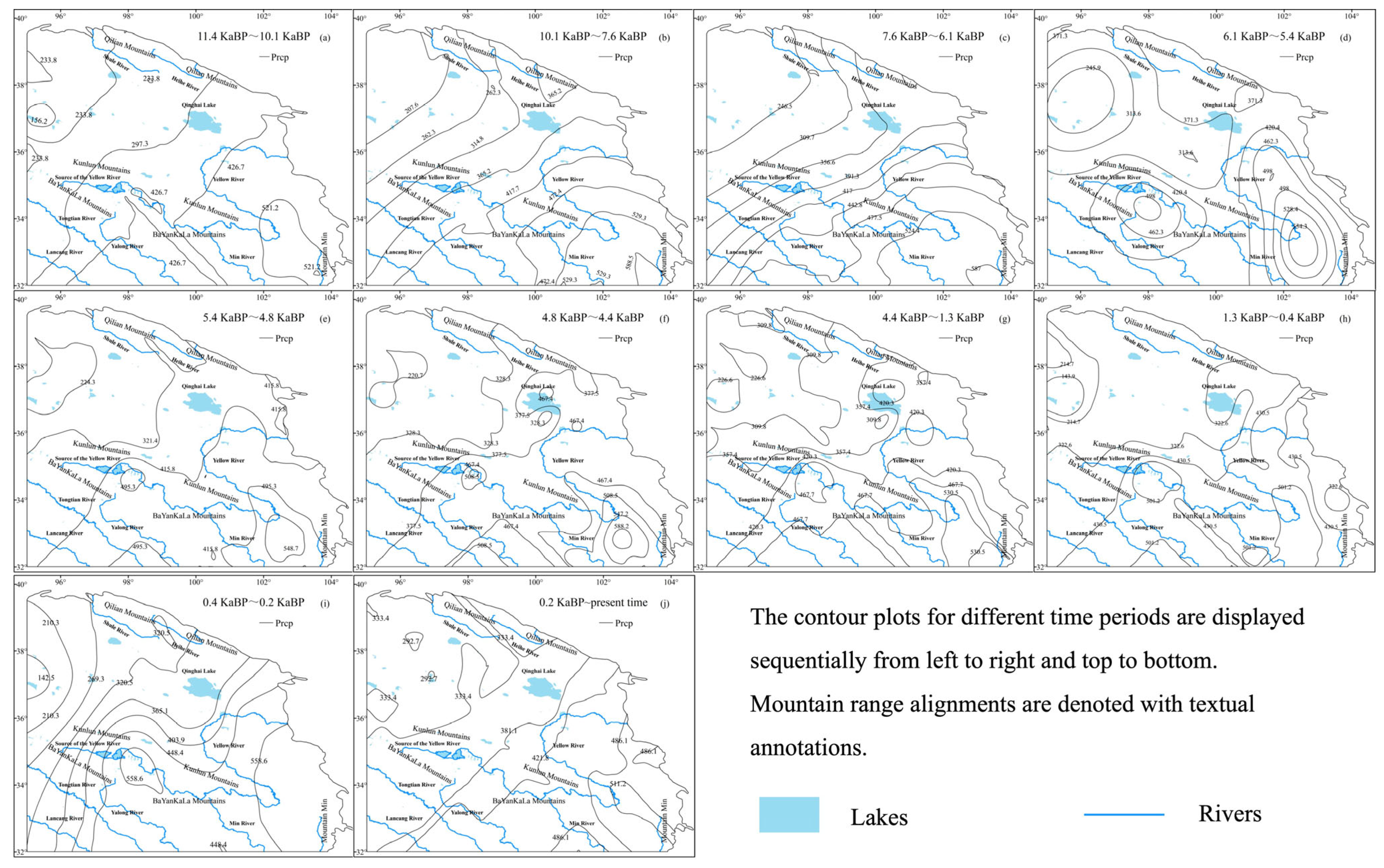
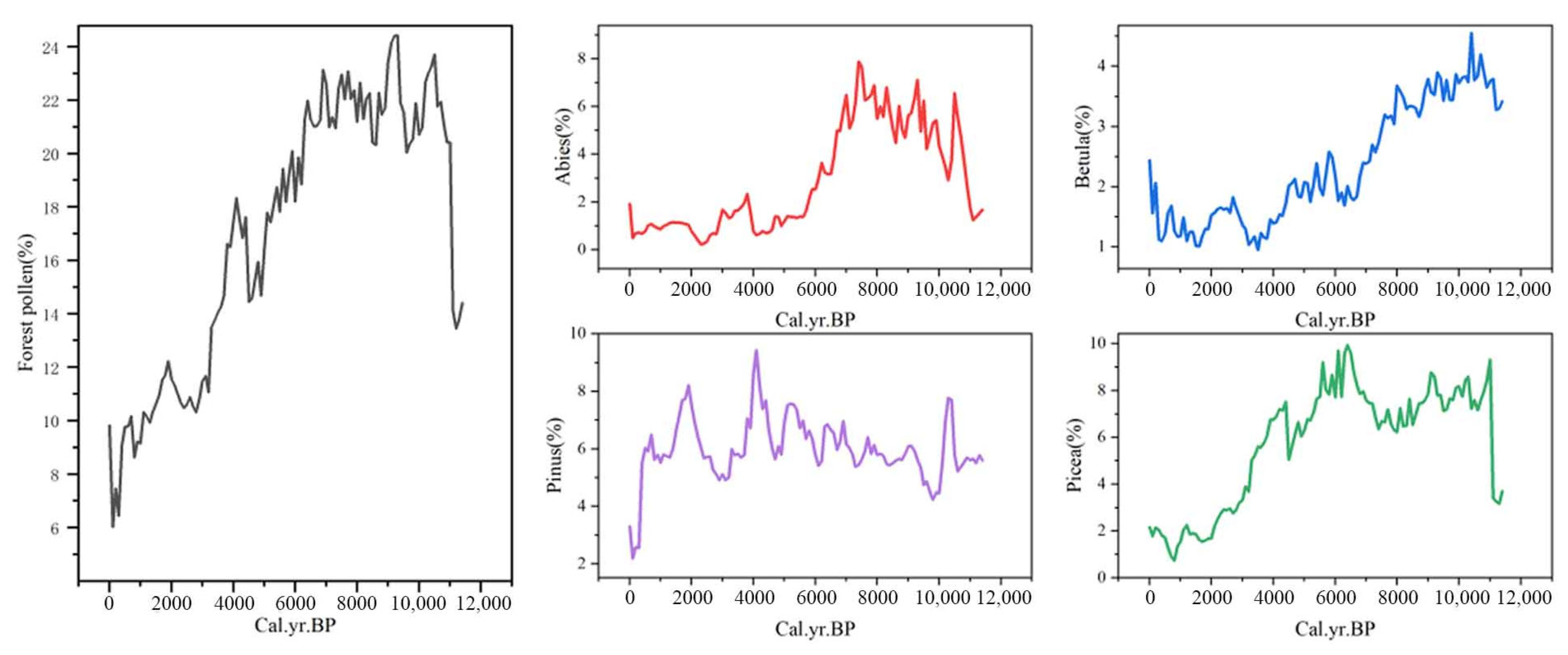


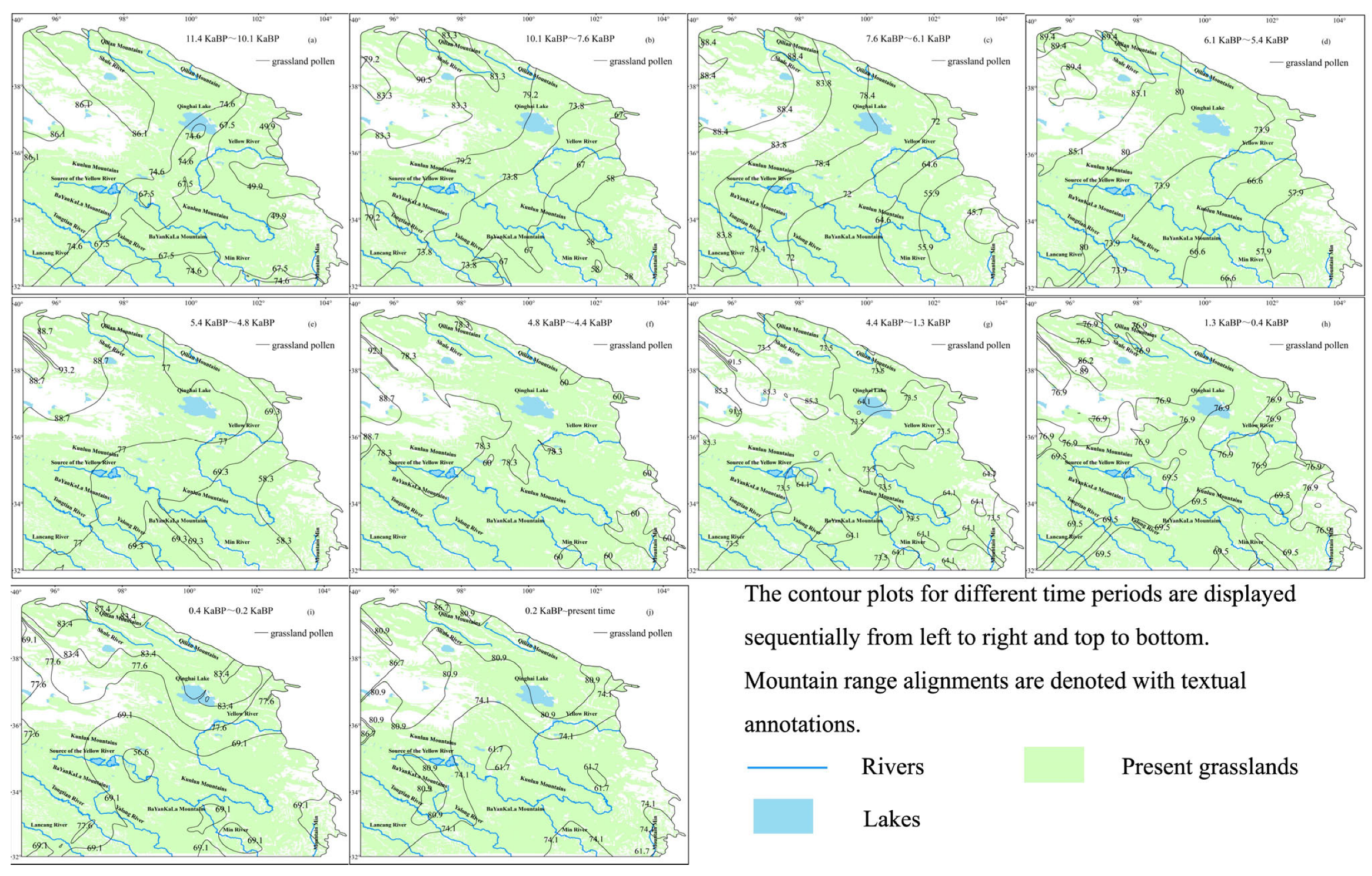
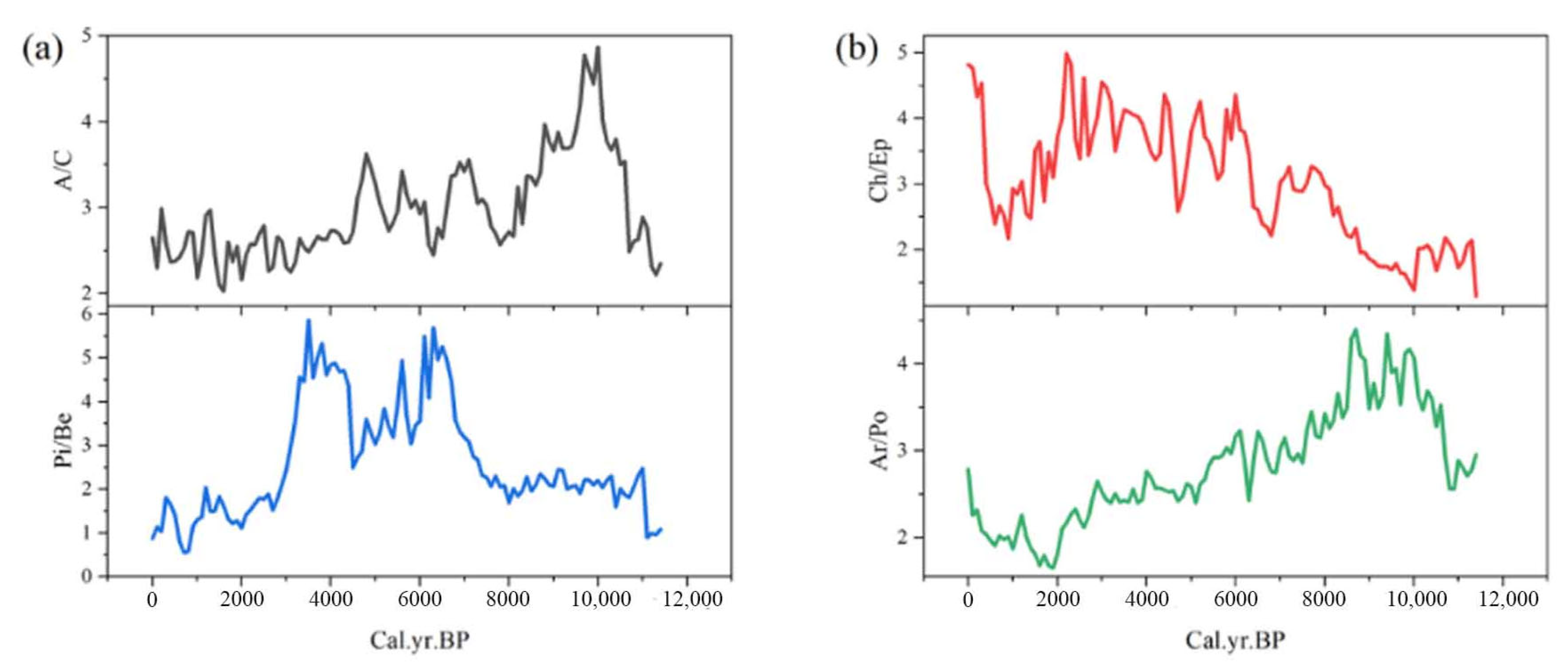


Disclaimer/Publisher’s Note: The statements, opinions and data contained in all publications are solely those of the individual author(s) and contributor(s) and not of MDPI and/or the editor(s). MDPI and/or the editor(s) disclaim responsibility for any injury to people or property resulting from any ideas, methods, instructions or products referred to in the content. |
© 2025 by the authors. Licensee MDPI, Basel, Switzerland. This article is an open access article distributed under the terms and conditions of the Creative Commons Attribution (CC BY) license (https://creativecommons.org/licenses/by/4.0/).
Share and Cite
Zhang, H.; Chen, H.; Zhang, Y.; Wang, Z.; Liu, Z. Climatic Changes and Vegetation Responses During Holocene Characteristic Period in the Northeastern Qinghai–Tibet Plateau. Life 2025, 15, 572. https://doi.org/10.3390/life15040572
Zhang H, Chen H, Zhang Y, Wang Z, Liu Z. Climatic Changes and Vegetation Responses During Holocene Characteristic Period in the Northeastern Qinghai–Tibet Plateau. Life. 2025; 15(4):572. https://doi.org/10.3390/life15040572
Chicago/Turabian StyleZhang, Huayong, Hao Chen, Yihe Zhang, Zhongyu Wang, and Zhao Liu. 2025. "Climatic Changes and Vegetation Responses During Holocene Characteristic Period in the Northeastern Qinghai–Tibet Plateau" Life 15, no. 4: 572. https://doi.org/10.3390/life15040572
APA StyleZhang, H., Chen, H., Zhang, Y., Wang, Z., & Liu, Z. (2025). Climatic Changes and Vegetation Responses During Holocene Characteristic Period in the Northeastern Qinghai–Tibet Plateau. Life, 15(4), 572. https://doi.org/10.3390/life15040572








